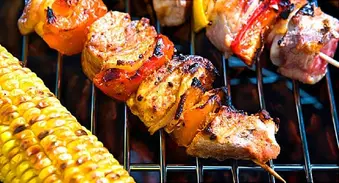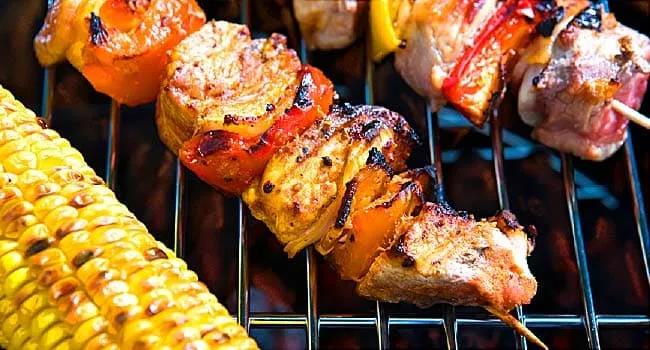Grilling Quiz: Test Your Cooking Smarts

Only amateurs barbecue meat over high heat.
- True
- False
Barbecue masters know that grilling meat at high temperatures can burn or char the outside and leave the inside underdone. Medium or low heat produces tastier, healthier food -- whether on a gas or a charcoal grill. On a charcoal grill, medium or low heat gives coals a slight red glow and a covering of gray ash. If you can hold your hand above the heat at cooking height for 4-5 seconds, you should be good to go.
You can tell if ground beef contains "pink slime" by looking at the label.
- True
- False
You've probably heard about "pink slime," the low-cost beef filler that is treated with ammonia to kill bacteria. But how can you avoid it? Since "ammonium hydroxide" is considered a processing aid, it doesn't need to be listed on food labels. But many fast-food chains and grocery stores have stopped selling beef that contains it. Check the web site of your favorite store, or ask at the meat counter.
It's safe to eat rare hamburger as long as it's warm.
- True
- False
Bacteria on the surface of ground beef can get mixed inside when you make hamburger patties. So don't skimp on the cooking time. As a rule, cook a 4-ounce ground beef patty that is about 1/2 inch thick and 4 inches wide over medium coals for 11 to 13 minutes. With a gas grill, check the manual for cooking times. A meat thermometer should read 160 F to make sure your patties are thoroughly cooked.
Which is best for starting a charcoal grill?
- Self-starting charcoal
- Lighter fluid and a long match
- A charcoal chimney starter
If you don't want to flavor that juicy steak with chemicals, skip lighter fluid and self-starting charcoal. They contain toxic substances that may pass into grilled food. Lighter fluid is made from petroleum products, which also pollute ground-level air. So fire up the grill with a chimney or electric starter. Instead of briquettes, burn wood chips or lump charcoal, which are chemical-free.
How long can you keep fresh beef ribs or steaks in the refrigerator?
- 1 to 2 days
- 3 to 5 days
- A week
To avoid spoiling, cook refrigerated beef ribs or steaks within 3 to 5 days of purchase or before the "use by" date, if there is one on the label. Poultry and ground meat go bad faster, so cook them within 1 to 2 days. Otherwise, freeze meat to keep it safe until you're ready to cook it.
Which meat needs to get the hottest to kill bacteria?
- Pork
- Steak
- Chicken
The temperature inside chicken needs to reach 165 degrees F or more to kill bacteria. As a general rule, that means grilling chicken thighs, legs, or a 6-ounce breast with bones for 10 to 15 minutes on each side. You can flip a boneless breast after 6 to 8 minutes and wings after 8 to 12 minutes. Steaks, roasts, and chops should reach an internal temperature of at least 145 degrees F and ground meats 160 degrees F.
Meat is done if you cut into it and it's no longer red inside.
- True
- False
You can't really go by inside color. And if you cut into the meat, the juices will pour out, drying it out. Grill master Bobby Flay goes by touch: The longer meat, fish, or poultry cooks, the firmer it gets. So a steak cooked medium should be springy, not squishy (rare) or taut (well done). Of course, the only surefire way to check for doneness is with a meat thermometer.
Sausages should be grilled over high heat to kill bacteria.
- True
- False
Low and slow is the way to go with fresh sausages, like Italian and fresh bratwurst. Over low heat, the skin won't burn before the inside is cooked through. That also keeps the skin from splitting and dripping juices, which flare up flames. For a flavor kick and to cut grill time, simmer sausages in water and beer for about 15 minutes first, and finish them over medium-low heat.
You shouldn't thaw meat or poultry:
- In the microwave
- In the refrigerator
- At room temperature
Bacteria can grow on food that's left out to defrost. For safety, slow thawing in the refrigerator is best. Most food will thaw in a day or two in the fridge. If you forget or you don't have time, you can quick-thaw food in a sealed bag in cold water or in the microwave if you're going to cook it right after. If you use cold water, change it every half-hour and keep it cold.
Eating grilled meat may increase your risk of cancer.
- True
- False
The risk is pretty small, but cooking meat over hot open flames can cause some harmful chemicals to form. Fortunately, it's easy to reduce the risk:
- Don't eat well-done or burned parts of meat.
- Leaner cuts of meat prevent dripping fat from causing flare-ups, which can deposit carcinogens on the meat.
- Trim fat. Remove skin from chicken.
- Partially cook meat in the microwave or oven or simmer it in liquid so it isn't on the grill as long.
- Flip meat on the grill often.
- Grill fish and chicken on top of foil.
- Grill fruits, vegetables, and veggie burgers, which don't have those cancer-causing chemicals.
- Reduce the heat -- cooking at slightly lower temperatures is enough to substantially reduce cancer-causing chemicals
Marinating meat before grilling may help prevent cancer-causing chemicals.
- True
- False
Marinating meat, even for just 10 minutes, is a triple-win for grillers. It brings out flavor and moisture and helps reduce possible cancer-causing chemicals. Thin, oil-free marinades, especially with vinegar or citrus, are best. Thicker, store-bought marinades and those with honey, sugar, or tomato tend to char. Use those only in the last minute or two of grilling.
The best way to cook kebabs is to leave a little space between the meat and the veggies.
- True
- False
It is a good idea to put about 1/2 inch between chunks of food on your kebab. It can help everything cook through more quickly. But the very best way would be to cook meat and vegetables on different skewers. That’s because veggies and meats can need different cooking times to be done, says chef and food science whiz Alton Brown. Plus, it cuts back on the chance of germs moving between the meat and veggies.Try putting slow-cooking veggies like sweet potatoes on one kebab, fast-cookers like zucchini and mushrooms on another, and meat on another.However, most people cook them all together. That's OK. The risk of germ mixing is small when you make sure everything is well-cooked. Keep cooking and turning your kebabs until the meat is firm, but yielding.
To be safe, how far away should you use your grill from the house?
- 5 feet
- 10 feet
- 15 feet
Grilling close to a house, deck railing, eaves, or overhead branches is a serious fire hazard. And grilling in an enclosed or partially enclosed space can expose you to deadly carbon monoxide fumes; so don't wheel the grill into the garage, a camper, or a tent to cook. Propane and charcoal grills should be used outdoors only. If it rains on your party, move inside and finish cooking on the stove.
To season your charcoal grill, don't clean it.
- True
- False
Ancient grease and food are health hazards, not flavor enhancers on the grill. Brush burnt bits of food off grates while they're still warm with a wire brush. Then soak the grates in warm, sudsy water and rinse. Dump used charcoal to cut down on smoke and bad flavors. Wipe off grease or fat buildup in the trays below the grill to prevent fires and flare-ups. Clean gas grills according to the owner's manual.
Juicier burgers are healthier burgers.
- True
- False
When juice from meat drips on hot coals, it increases smoke and flares up flames, which may leave harmful chemicals on food. So keeping the juices in burgers is both tastier and healthier. To avoid squishing out juice and drying hamburgers out, don't flatten them with a spatula while they're cooking. Flipping burgers frequently cooks them more evenly and also prevents drips.
